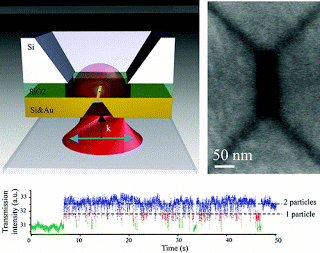1. Nanoletters – Enhanced Optical Trapping and Arrangement of Nano-Objects in a Plasmonic Nanocavity
Gentle manipulation of micrometer-sized dielectric objects with optical forces has found many applications in both life and physical sciences. To further extend optical trapping toward the true nanometer scale, we present an original approach combining self-induced back action (SIBA) trapping with the latest advances in nanoscale plasmon engineering. The designed resonant trap, formed by a rectangular plasmonic nanopore, is successfully tested on 22 nm polystyrene beads, showing both single- and double-bead trapping events. The mechanism responsible for the higher stability of the double-bead trapping is discussed, in light of the statistical analysis of the experimental data and numerical calculations. Furthermore, we propose a figure of merit that we use to quantify the achieved trapping efficiency and compare it to prior optical nanotweezers. Our approach may open new routes toward ultra-accurate immobilization and arrangement of nanoscale objects, such as biomolecules.
3 pages of supplemental information
2. Nanoletters – Plasmonic Nanoparticle Chain in a Light Field: A Resonant Optical Sail
Optical trapping and driving of small objects has become a topic of increasing interest in multidisciplinary sciences. We propose to use a chain made of metallic nanoparticles as a resonant light sail, attached by one end point to a transparent object and propelling it by the use of electromagnetic radiation. Driving forces exerted on the chain are theoretically studied as a function of radiation’s wavelength and chain’s alignments with respect to the direction of radiation. Interestingly, there is a window in the frequency spectrum in which null–torque equilibrium configuration, with minimum geometric cross section, corresponds to a maximum in the driving force.
If you liked this article, please give it a quick review on ycombinator or StumbleUpon. Thanks

Brian Wang is a Futurist Thought Leader and a popular Science blogger with 1 million readers per month. His blog Nextbigfuture.com is ranked #1 Science News Blog. It covers many disruptive technology and trends including Space, Robotics, Artificial Intelligence, Medicine, Anti-aging Biotechnology, and Nanotechnology.
Known for identifying cutting edge technologies, he is currently a Co-Founder of a startup and fundraiser for high potential early-stage companies. He is the Head of Research for Allocations for deep technology investments and an Angel Investor at Space Angels.
A frequent speaker at corporations, he has been a TEDx speaker, a Singularity University speaker and guest at numerous interviews for radio and podcasts. He is open to public speaking and advising engagements.



